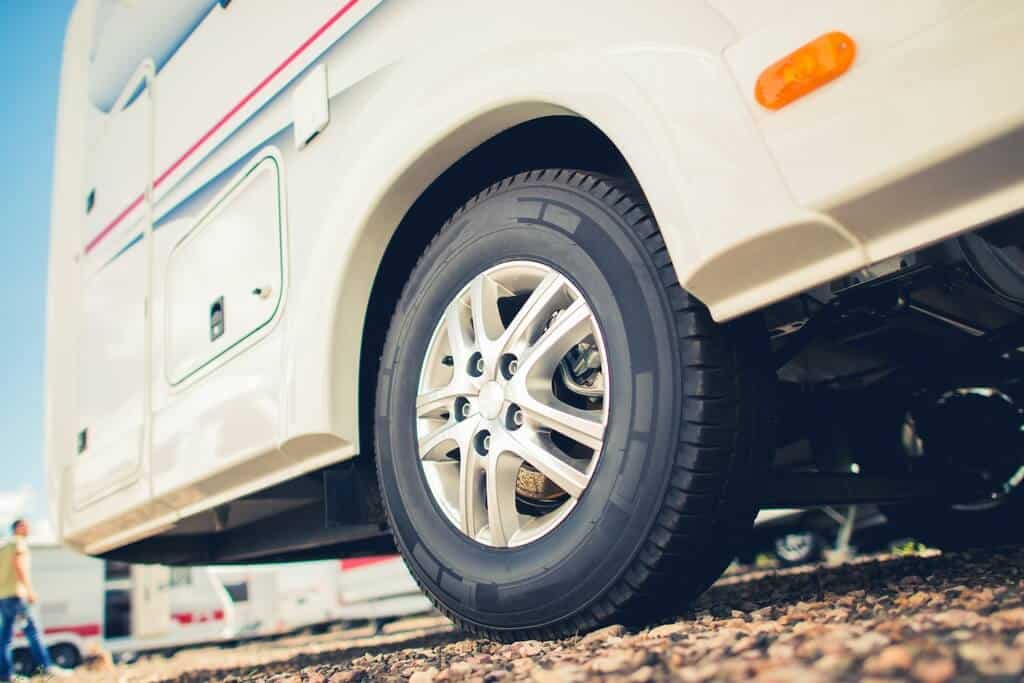Every time you hit the road in your RV – and actually when you have it parked, too—your life is sitting on four wheels that ride on air . . . in tires. Those tires are the most important contact your RV has with the road. Everything is bigger in an RV, and that includes the impact of a tire blowout. Not to mention the huge inconvenience of changing a tire in the dark on an isolated road. Furthermore, a tire blowout can cause an accident that could severely injure the passengers or worse.
That makes a regular tire inspection the most important RV maintenance that needs to be performed for you and your fellow travelers to stay safe in your RV. Let’s take a close look at how to go about it.
Air pressure
Check the air pressure every time you head out. Unhook all the connections and inspect the tires. Make it a habit. For RVs, use a heavy-pressure gauge, not the typical gauge for a passenger car, and be sure you know what the manufacturer’s recommendation is for the air pressure. Recommendations may vary by the make of RV as well as by the tire’s manufacturer. Proper air pressure also saves on gas mileage.
Age of the tires
After 2000 all tires made in the US are labeled with the date of their manufacture. Near the tire’s outside rim is an identification number with the date encoded in the last four digits. The last two digits are the year, and the preceding two digits stand for the week of the year it was made. For example, the number 2420 means the 24th week of the year 2020.
Tire tread
Use that information when making a further inspection, such as how much tread remains on the tire. Use a penny. Insert an upside-down penny in the space between the treads. The top half of A. Lincoln’s head should be hidden. The more you see of Lincoln’s head, the less tread exists.
To extend and even out the tread wear, have the tires rotated and balanced and the alignment checked at regular intervals, as indicated in your owner’s manual, but at least every 5,000 to 8,000 miles. Your tires will last longer too.
Tread wear bars
A small, raised square knob positioned in various places between the treads is the best indicator of when tires should be replaced. When the tread surface is at or below the top of the tread wear bar, it’s time to replace those tires. (If you are not sure what those look like, do an image search for examples.) The various placements of these bars will also show whether the tire is wearing unevenly.
Wheel alignment and tire rotation
Uneven wear means the wheel alignment should be adjusted by a professional tire service. Wheel alignment is important for more than just tire wear, of course. Having all the tires angled correctly in respect to the wheel hub and pointing straight ahead reduces engine strain and facilitates steering. It’s not just about tire health.
Alignment can be altered by a pothole, a bump, a rough road. When driving, if the RV keeps drifting or pulling to the side, it’s time for a check of the alignment. And the tires!
Now, put all that information together to make a decision about your confidence in your tire condition. When factoring in the age of the tire, check this article by Roger Marble, a tire design engineer with 40 years of experience.
Helpful accessories
Consider installing a tire pressure monitoring system (TPMS) if one is not already on your rig. Another useful addition is the RettroBand wheel enhancement for dealing with front-tire blowouts. It supports the tire for a short distance after a blowout.
Riverbound Custom Storage & RV Park is conveniently located near Lake Havasu City, AZ, with all the benefits for tire purchases or repairs there.Riverbound also has experts on staff to answer questions and help with any problems you may have. At the same time, you can enjoy a full range of the advantages of this luxury park: sports courts, pool, children’s playground, café, laundromat and more. Nearby are all kinds of fun things to do, in the water and the land.


